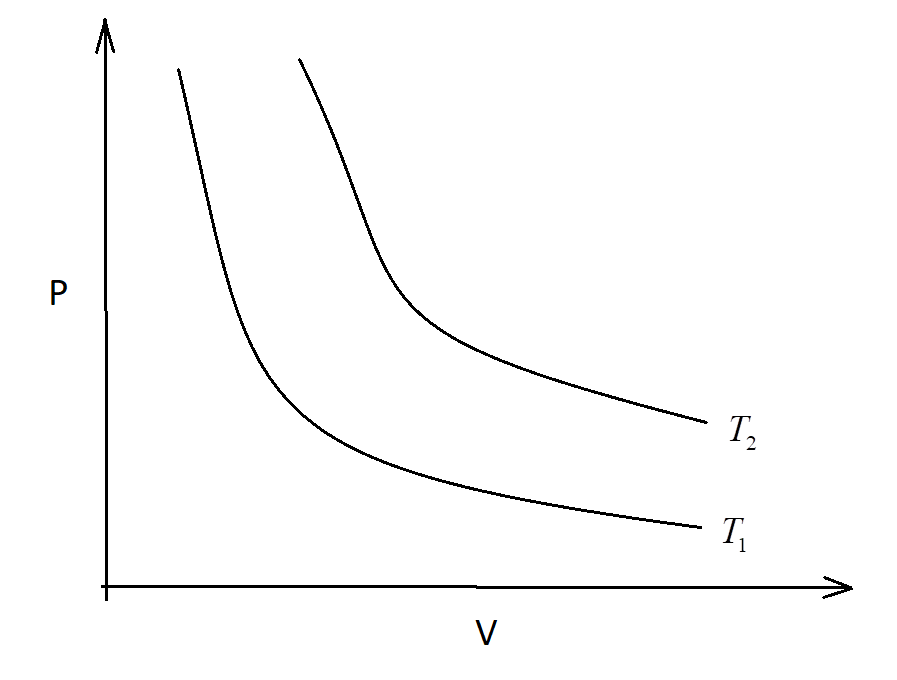
At constant pressure, density of a gas is:

A. directly proportional to absolute temperature
B. inversely proportional to absolute temperature
C. independent of temperature
D. directly proportional to square root of absolute temperature

Answer
462k+ views
Hint: Before we solve this question, it is important to understand the mathematical definition of the quantity density. It is the ratio of mass of the body to its volume.
Density, $\rho = \dfrac{m}{V}$
where m = mass of the body and V = volume of the body.
Complete step-by-step solution:
For any gas, the state of the gas at any instant of time, is defined by four basic quantities : pressure P, volume V, temperature T and quantity of substance (or number of moles, n).
There are 4 laws known as Gas laws, that establish the relationship between these four state variables. They are: i) Boyle’s law: $P \propto \dfrac{1}{V}$ ii) Charles’s law: $V \propto \dfrac{1}{T}$ iii) Gay-Lussac’s law: $P \propto T$ iv) Avogadro’s law: $V \propto n$
By combining these 4 individual gas laws, we obtain an important equation known as the Ideal Gas Equation.
Ideal gas equation:
$PV \propto nT$
By removing the proportionality, we get –
$PV = nRT$
where R = universal gas constant.
The number of moles of a gas is equal to the mass of the gas per unit molar mass (or mass of 1 mole of the gas) of the gas. Hence,
$n = \dfrac{m}{M}$
where m = mass of the gas, M = molar mass or mass of 1 mole of the gas
Substituting in the ideal gas equation,
$PV = \dfrac{m}{M}RT$
By rearranging the equation,
$P = \dfrac{m}{V}\dfrac{R}{M}T$
The density of the gas is the mass per unit volume of the gas.
Hence, $\rho = \dfrac{m}{V}$
Also, we have –
$R' = \dfrac{R}{M}$
where $R'$ is called a specific gas constant for the gas and is equal to the universal gas constant divided by the molar mass of the gas.
Thus, we have –
$P = \rho R'T$
Given, that the pressure is constant, we get –
$\rho = \dfrac{P}{{R'T}}$
$\therefore \rho \propto \dfrac{1}{T}$
Hence, the density of the gas is inversely proportional to the absolute temperature.
Hence, the correct option is Option B.
Note: The students should exercise caution while substituting the values of temperature in problems related to this equation. The temperature should be compulsorily converted to kelvin scale and cross-checked before substituting because here, it is given as absolute temperature, which is the temperature in the kelvin scale.
Density, $\rho = \dfrac{m}{V}$
where m = mass of the body and V = volume of the body.
Complete step-by-step solution:
For any gas, the state of the gas at any instant of time, is defined by four basic quantities : pressure P, volume V, temperature T and quantity of substance (or number of moles, n).
There are 4 laws known as Gas laws, that establish the relationship between these four state variables. They are: i) Boyle’s law: $P \propto \dfrac{1}{V}$ ii) Charles’s law: $V \propto \dfrac{1}{T}$ iii) Gay-Lussac’s law: $P \propto T$ iv) Avogadro’s law: $V \propto n$
By combining these 4 individual gas laws, we obtain an important equation known as the Ideal Gas Equation.
Ideal gas equation:
$PV \propto nT$
By removing the proportionality, we get –
$PV = nRT$
where R = universal gas constant.
The number of moles of a gas is equal to the mass of the gas per unit molar mass (or mass of 1 mole of the gas) of the gas. Hence,
$n = \dfrac{m}{M}$
where m = mass of the gas, M = molar mass or mass of 1 mole of the gas
Substituting in the ideal gas equation,
$PV = \dfrac{m}{M}RT$
By rearranging the equation,
$P = \dfrac{m}{V}\dfrac{R}{M}T$
The density of the gas is the mass per unit volume of the gas.
Hence, $\rho = \dfrac{m}{V}$
Also, we have –
$R' = \dfrac{R}{M}$
where $R'$ is called a specific gas constant for the gas and is equal to the universal gas constant divided by the molar mass of the gas.
Thus, we have –
$P = \rho R'T$
Given, that the pressure is constant, we get –
$\rho = \dfrac{P}{{R'T}}$
$\therefore \rho \propto \dfrac{1}{T}$
Hence, the density of the gas is inversely proportional to the absolute temperature.
Hence, the correct option is Option B.
Note: The students should exercise caution while substituting the values of temperature in problems related to this equation. The temperature should be compulsorily converted to kelvin scale and cross-checked before substituting because here, it is given as absolute temperature, which is the temperature in the kelvin scale.
Recently Updated Pages
Can anyone list 10 advantages and disadvantages of friction

What are the Components of Financial System?

How do you arrange NH4 + BF3 H2O C2H2 in increasing class 11 chemistry CBSE

Is H mCT and q mCT the same thing If so which is more class 11 chemistry CBSE

What are the possible quantum number for the last outermost class 11 chemistry CBSE

Is C2 paramagnetic or diamagnetic class 11 chemistry CBSE

Trending doubts
Which is not a source of freshwater 1 Glaciers and class 11 chemistry CBSE

10 examples of friction in our daily life

The correct order of melting point of 14th group elements class 11 chemistry CBSE

Difference Between Prokaryotic Cells and Eukaryotic Cells

One Metric ton is equal to kg A 10000 B 1000 C 100 class 11 physics CBSE

What is the specific heat capacity of ice water and class 11 physics CBSE




